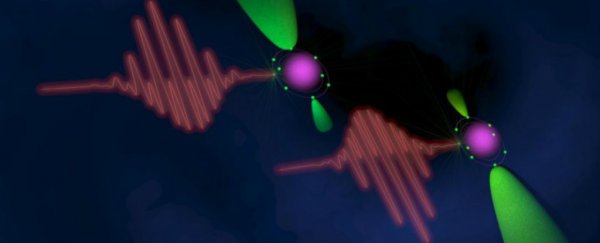For the first time ever, a team of international scientists has been able to control and monitor the direction of electrons ejected from an atom in real time. The researchers used the FERMI free electron laser in Italy to complete the process, which took only a few attoseconds, or a billionth of a billionth of a second.
The fact we can control these electrons is awesome enough, and means we could study and control the movement of electrons between two elements in a chemical compound. But what's even cooler is that we can now study how electrons move in ultrafast processes - such as photosynthesis and combustion - that we haven't been able to study in real-time before.
"The next step will be to apply the technique we have demonstrated to the study of more complex processes which occur on the attosecond scale such as catalytic processes and atmospheric chemistry," said lead researcher Kevin Prince, a chemist with the Molecular Model Discovery Laboratory at Swinburne University of Technology in Australia.
Unlike regular lasers, which shoot beams of photons, the FERMI free electron laser consists of high-speed electrons moving through a magnetic structure. It's also tunable, allowing researchers to change frequency range from microwaves through to X-ray and infrared.
Using this technology, they produced two electron beams at different wavelengths. The short wavelengths were able to control the electrons movement, changing their direction. This control was only maintained for a tiny amount of time - a few attoseconds - but even knowing that it happened is exceptionally cool.
"Atoms in a molecule move on the scale of femtoseconds - a few millionths of a billionth of a second," said Prince. "But electrons, which are the basis of chemical bonds, are much faster and in the processes they cause, they move a thousand times faster - on the scale of tens or hundreds of attoseconds."
The research was a collaboration between the Swinburne team and researchers in Italy, Japan, Russia, the US, and Germany.
"Like many in the scientific community we have been working for years to develop innovative analytical methods with attosecond resolution to study and control fast dynamics," said Prince. "With this work, that exploits the exceptional properties of the laser light from FERMI, we can say we have finally achieved our goal."
The experiment, published in Nature Photonics, creates an exciting precedent for the future. Being able to measure electrons in attoseconds will allow researchers to move onto investigating real-life processes that happen ultrafast - something that we haven't been able to do before. And who knows what doors that will open.
Swinburne University of Technology is a sponsor of ScienceAlert. Find out more about their innovative research.
